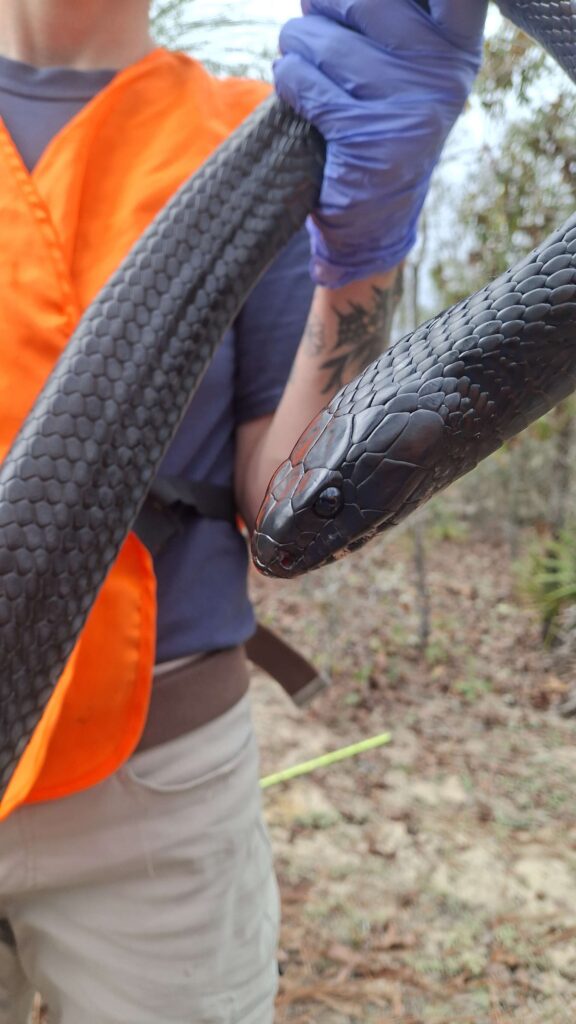Summary of Surveying eastern indigo snake habitats:
Roxanne Buckman, a keeper at Zoo Atlanta’s Ambassador Animals Department, participated in field surveys for eastern indigo snakes in southern Georgia. Funded by the Mickelberg Field Conservation Grant, she joined the Orianne Society in surveying indigo snake habitats from November to February. The Orianne Society, focused on reptiles and amphibians, conducts these surveys at the Longleaf Stewardship Center, covering about 70 sites over a three-year rotation. Roxanne spent a week helping map gopher tortoise burrows, crucial shelters for indigo snakes, and encountered harsh conditions like overgrown, fire-suppressed sites and post-hurricane damage. During the surveys, the team found three indigo snakes, which were examined and tagged. Roxanne named one of the snakes “Larry” after consulting with her son. The data collected is vital for monitoring snake populations, disease spread, and ensuring the conservation efforts for these species.
- The Importance of Surveying Eastern Indigo Snake Habitats
- The Role of Gopher Tortoise Burrows in Indigo Snake Ecology
- Field Research Challenges and Observations
- Procedures for Capturing and Examining Eastern Indigo Snakes
- Contributions to Conservation and Health Monitoring
Surveying the habitats of eastern indigo snakes in southern Georgia provides crucial insights into their ecological needs and population status, offering a compass for ongoing conservation efforts. These surveys, spearheaded by organizations like The Orianne Society, are vital for understanding how these apex predators interact with their environment. By focusing on these snake habitats, researchers aim to not only preserve the species but also enrich the biodiversity of the southeastern United States.
Eastern indigo snakes, listed as threatened under the Endangered Species Act, occupy diverse habitats across the southeastern United States, primarily longleaf pine ecosystems. Surveys conducted between November and February are essential, as they align with the snakes’ active period. The Orianne Society, with their Longleaf Stewardship Center in Georgia, is at the forefront of this research, examining approximately 70 sites rotationally every three years. The data gathered not only informs the health and behavior of individual snakes but also reflects broader environmental conditions.
A unique aspect of the eastern indigo snake’s habitat is its reliance on gopher tortoise burrows. By mapping these burrows, researchers can predict areas of indigo snake activity since these burrows offer refuge, especially during the colder months. Understanding the relationship between gopher tortoises and indigo snakes helps conservationists develop strategies that benefit both species. Surveys often involve revisiting GPS-marked burrows to assess their current status and to identify any changes in the ecosystem that might affect these reptiles.
Field surveys are not without their challenges. Many sites have faced fire suppression, leading to overgrown vegetation, which can inhibit both gopher populations and indigo snakes. The thick underbrush, combined with natural obstacles like hurricanes, presents a demanding environment for researchers. In addition to physical challenges such as thorns and adverse weather conditions, surveys are conducted with considerations for safety, as it is often deer hunting season.
Despite these hurdles, researchers collect valuable data by spotting and capturing snakes. Encountering three snakes in a week is considered successful, given the species’ elusive nature and solitary habits. Each captured snake undergoes a thorough examination to assess its health and gather baseline data. This includes measuring, weighing, and checking for microchips known as PIT tags, which help track individual snakes throughout their lives.
The collection of biological samples from each snake aids in monitoring diseases that could impact not only the captured snakes but also the larger reptile community. Snake fungal disease and snake lung worm are two significant pathogens of concern. The former can cause severe lesions, while the latter affects respiratory functions. These health assessments are essential for understanding the impact of pathogens on desert ecosystems and for devising intervention strategies.
Every research experience generates significant insights. For instance, the excitement of coming across an untagged indigo snake in the field allows researchers to contribute directly to the species’ population database. Naming a snake, like ‘Larry,’ adds a personal touch to the scientific endeavor and reaffirms the purpose behind conservation work—community engagement and education.
The rigorous scientific processes and data sharing initiatives exemplified by groups like the Orianne Society demonstrate an enduring commitment to preserving the eastern indigo snake. By integrating habitat surveys and health assessments, they foster informed conservation planning. The knowledge gained not only has immediate impacts but also lays the groundwork for future generations to protect these magnificent reptiles.
In summary, the concerted efforts to survey and conserve eastern indigo snakes underscore a broader mission of preserving biodiversity. As researchers and conservationists continue their work, they harness the power of informed science to navigate the challenges faced by wildlife today. The pursuit to conserve these snakes is a testament to the importance of detailed habitat research and the unwavering dedication of those passionate about wildlife conservation.


